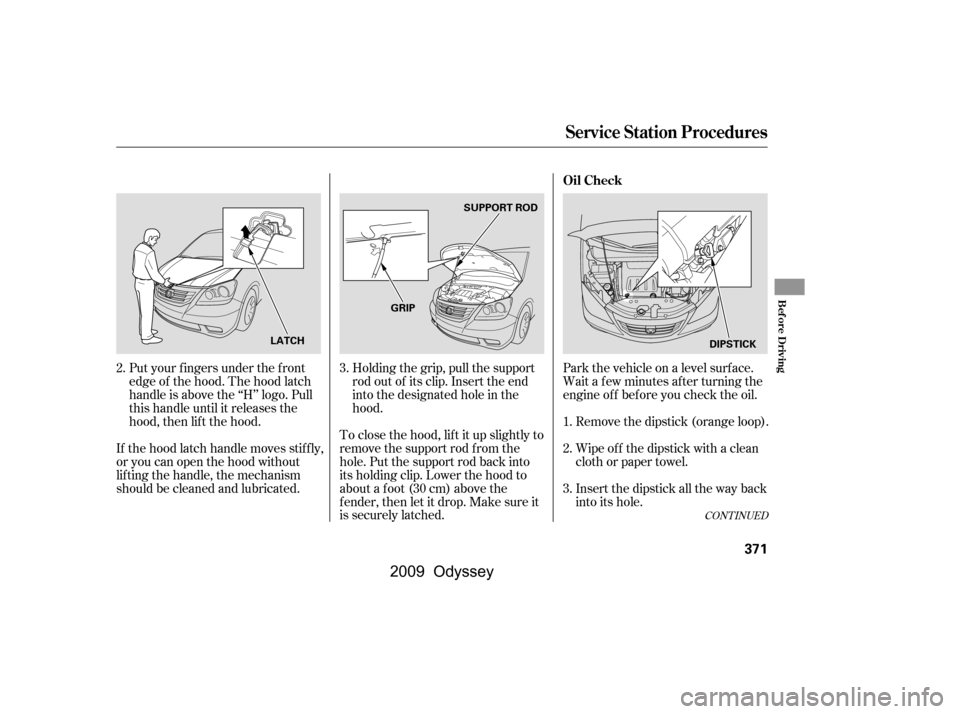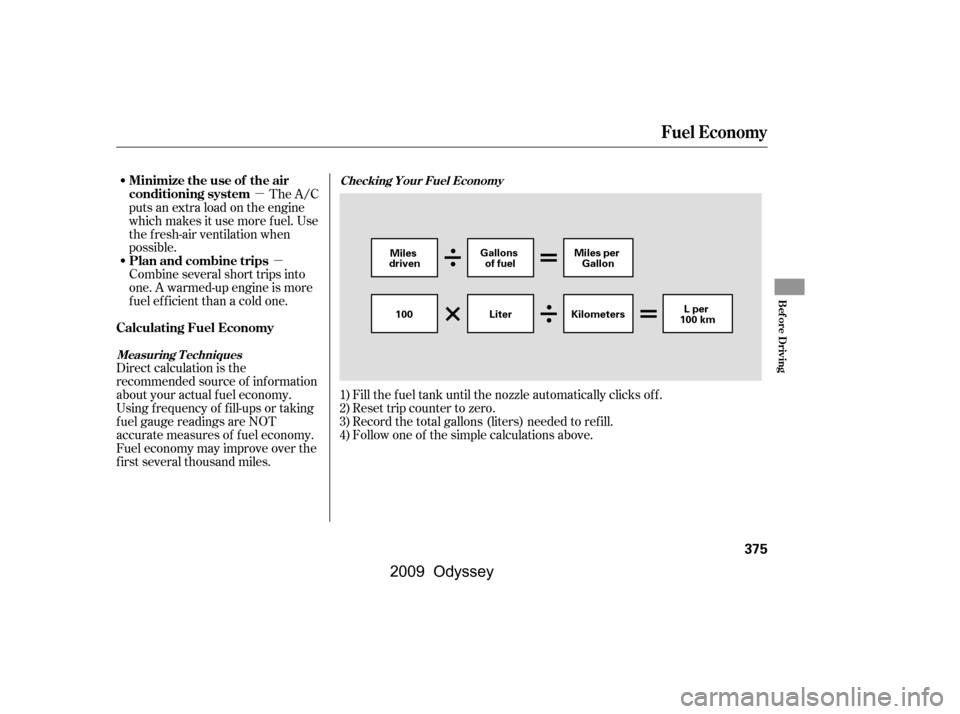Page 370 of 532
Bef ore you begin driving your
vehicle, you should know what
gasoline to use and how to check the
levels of important f luids. You also
need to know how to properly store
luggage or packages. The
inf ormation in this section will help
you. If you plan to add any
accessories to your vehicle, please
read the information in this section
first...............................
Break-in period .368
.................
Fuel Recommendation .368
.........
Service Station Procedures .369
....................................
Ref ueling .369
Opening and Closing the .......................................
Hood .370
...................................
Oil Check .371
.............
Engine Coolant Check .372
...............................
Fuel Economy .373
...
Accessories and Modif ications .376
.............................
Carrying Cargo .378
Bef ore Driving
Bef ore Driving
367
�\f���—�\f���—���
�y�
����\f����\f���y���
�(���������\f�y�\f�������y
2009 Odyssey
Page 371 of 532

Help assure your vehicle’s f uture
reliability and perf ormance by paying
extra attention to how you drive
during the f irst 600 miles (1,000 km).
During this period:Avoid full-throttle starts and rapid
acceleration.
Avoidhardbrakingforthefirst
200 miles (300 km).
Do not change the oil until the
scheduled maintenance time.
You should also f ollow these
recommendations with an
overhauled or exchanged engine, or
when the brakes are replaced. Do not tow a trailer.
In addition, in order to maintain good
perf ormance, f uel economy, and
emissions control, we strongly
recommend, in areas where it is
available, the use of gasoline that
does NOT contain manganese-based
f uel additives such as MMT.
Your vehicle is designed to operate
on unleaded gasoline with a pump
octane number of 87 or higher. Use
of a lower octane gasoline can cause
a persistent, heavy, metallic rapping
noise that can lead to engine damage.
Some gasoline today is blended with
oxygenates such as ethanol or
MTBE. Your vehicle is designed to
operate on oxygenated gasoline
containing up to 10% ethanol by
volume and up to 15% MTBE by
volume. Do not use gasoline
containing methanol.
If you notice any undesirable
operating symptoms, try another
service station or switch to another
brand of gasoline.
For f urther important f uel-related
inf ormation, please ref er to your.
Use of gasoline with these additives
may adversely af f ect perf ormance,
and cause the Malfunction Indicator
Lamp on your instrument panel to
come on. If this happens, contact
your dealer f or service.
We recommend using quality
gasolines containing detergent
additives that help prevent fuel
system and engine deposits.
Break-in Period
Fuel Recommendation
Quick Start Guide
Break-in Period, Fuel Recommendation
368
�\f���—�\f���—���
�y�
����\f������\f�y���
�(���������\f�y�\f�������y
2009 Odyssey
Page 372 of 532
Bef ore ref ueling, make sure the rear
sliding door on the driver’s side is
closed.
Park with the driver’s side closest
to the service station pump.
Open the f uel f ill door by pulling
on the handle under the lower lef t
corner of the dashboard.
Remove the f uel f ill cap slowly.
You may hear a hissing sound as
pressure inside the tank escapes.
The fuel fill cap is attached to the
f uel f iller with a tether. Insert the
attachment on the fuel fill cap into
the slit on the f uel f ill door.
1.
2.
3.
CONT INUED
Ref ueling
Service Station Procedures
Bef ore Driving
369
FUEL FILL CAP
Pull
FUEL FILL DOOR RELEASE HANDLE
TETHER
Gasoline is highly flammable
and explosive. You can be
burned or seriously injured
when handling fuel.
Stop the engine, and keep
heat, sparks, and flame away.
Handle fuel only outdoors.
Wipe up spills immediately.
�����—�����—���
�y�
�������������y���
�(�����������y���������y
2009 Odyssey
Page 374 of 532

Park the vehicle on a level surf ace.
Holding the grip, pull the support
rod out of its clip. Insert the end
into the designated hole in the
hood.
To close the hood, lif t it up slightly to
remove the support rod f rom the
hole. Put the support rod back into
its holding clip. Lower the hood to
about a f oot (30 cm) above the
f ender, then let it drop. Make sure it
is securely latched.
Put your f ingers under the f ront
edge of the hood. The hood latch
handle is above the ‘‘H’’ logo. Pull
this handle until it releases the
hood, then lif t the hood.
If the hood latch handle moves stif f ly,
or you can open the hood without
lif ting the handle, the mechanism
should be cleaned and lubricated. Wait a f ew minutes af ter turning the
engine of f bef ore you check the oil.
Remove the dipstick (orange loop).
Wipe of f the dipstick with a clean
cloth or paper towel.
Insert the dipstick all the way back
into its hole.
1.
3.
2.
3.
2.
CONT INUED
Service Station Procedures
Oil Check
Bef ore Driving
371
DIPSTICK
SUPPORT ROD
GRIP
LATCH
�\f���—�\f���—���
�y�
����\f��������y���
�(���������\f�y�\f�������y
2009 Odyssey
Page 375 of 532
Refer toon page f or inf ormation
about checking other items on your
vehicle.
Look at the coolant level in the
radiator reserve tank. Make sure it is
between the MAX and MIN lines. If
it is below the MIN line, see on page f or
inf ormation on adding the proper
coolant.
Remove the dipstick again, and
check the level. It should be
between the upper and lower
marks.
If it is near or below the lower mark,
see on page . 4.
426 430423
Service Station Procedures
Owner’s Maintenance
Checks
A dding
Engine Coolant Engine Coolant Check
A dding Engine Oil
372
MAX RESERVE TANK
MIN
UPPER MARK
LOWER MARK
�����—�����—���
�y�
�������������y���
�(�����������y���������y
2009 Odyssey
Page 377 of 532

�µ�µ�µ �µ
�µ �µ
�µ
Aggressive driving (hard
acceleration and braking)
Excessive idling, accelerating and
braking in stop-and-go traf f ic
Cold engine operation (engines
aremoreefficientwhenwarmed
up)
Driving with a heavy load or the
air conditioner running
Improperly inf lated tires
An underinf lated tire increases
‘‘rolling resistance,’’ which reduces
f uel economy.
It puts a heavier
load on the engine, increasing f uel
consumption. In
particular, a build-up of snow or
mud on your vehicle’s underside
adds weight and rolling resistance.
Frequent cleaning helps your f uel
economy.
The f ollowing f actors can lower your
vehicle’s f uel economy:
A properly maintained vehicle
maximizes f uel economy. Poor
maintenance can signif icantly reduce
f uel economy. Always maintain your
vehicle according to the maintenance
messages displayed on the multi-
inf ormation display (see
on page ).
For example: Idling
results in 0 miles per gallon. If your vehicle has a
manual transmission, you can
boost your f uel economy by up
shif ting as early as possible.
Aerodynamic drag has a big ef f ect
on f uel mileage at speeds above 45
mph (75 km/h). Reduce your
speed and you reduce the drag.
Trailers, car top carriers, roof
racks and bike racks are also big
contributors to increased drag.
Rapid
acceleration, abrupt cornering,
and hard braking increase fuel
consumption.
423
Fuel Economy Factors
Use the recommended viscosity
motor oil, displaying the A PI
Certif ication Seal (see page ).
Maintain proper tire inf lation
A void carrying excess weight in
your vehicle
K eep your vehicle clean
Improving Fuel Economy
Owner’s
Maintenance Checks Avoid excessive idling
Always drive in the highest gear
possible
Observe the speed limit
Drive moderately 426
Drive Ef f icient ly
Vehicle Maint enance
Fuel Economy
374
�\f���—�\f���—���
�y�
����\f����
���y���
�(���������\f�y�\f�������y
2009 Odyssey
Page 378 of 532

�µ�µ
Fill the f uel tank until the nozzle automatically clicks of f .
Reset trip counter to zero.
Record the total gallons (liters) needed to ref ill.
Follow one of the simple calculations above.
Direct calculation is the
recommended source of inf ormation
about your actual f uel economy.
Using f requency of f ill-ups or taking
f uel gauge readings are NOT
accurate measures of f uel economy.
Fuel economy may improve over the
f irst several thousand miles. The A/C
puts an extra load on the engine
which makes it use more f uel. Use
the f resh-air ventilation when
possible.
Combine several short trips into
one. A warmed-up engine is more
f uel ef f icient than a cold one.
1)
2)
3)
4)
Checking Your Fuel Economy
Measuring T echniques
Calculating Fuel Economy Minimize the use of the air
conditioning system
Plan and combine trips
Fuel Economy
Bef ore Driving
375
Miles
driven Gallons
of fuel Miles per
Gallon
100 KilometersLper
100 km
Liter
�\f���—�\f���—���
�y�
����\f��������y���
�(���������\f�y�\f�����\f�y
2009 Odyssey
Page 386 of 532

�µ
�µ
This section gives you tips on
starting the engine under various
conditions, and how to operate the
automatic transmissions. It also
includes important inf ormation on
parking your vehicle, the braking
system, the vehicle stability assist
(VSA
) system, the tire pressure
monitoring system (TPMS), and
f acts you need if you are planning to
tow a trailer. ........................
Preparing to Drive .384
.......................
Starting the Engine .385
..............
Automatic Transmission .386
...........................................
Parking .390
.............................
Braking System .391
...............
Anti-lock Brakes (ABS) .392
Vehicle Stability Assist (VSA
),
aka Electronic Stability ........
Control (ESC), System .394
Tire Pressure Monitoring System (TPMS) Except Touring ....................................
models .396
Tire Pressure Monitoring System ....
(TPMS) Touring models .399
...........................
Towing a Trailer .404
...................
Towing Your Vehicle .411
Driving
Driving
383
�\f���—�\f���—���
�y�
����\f��������y���
�(���������\f�y�\f�������y
2009 Odyssey